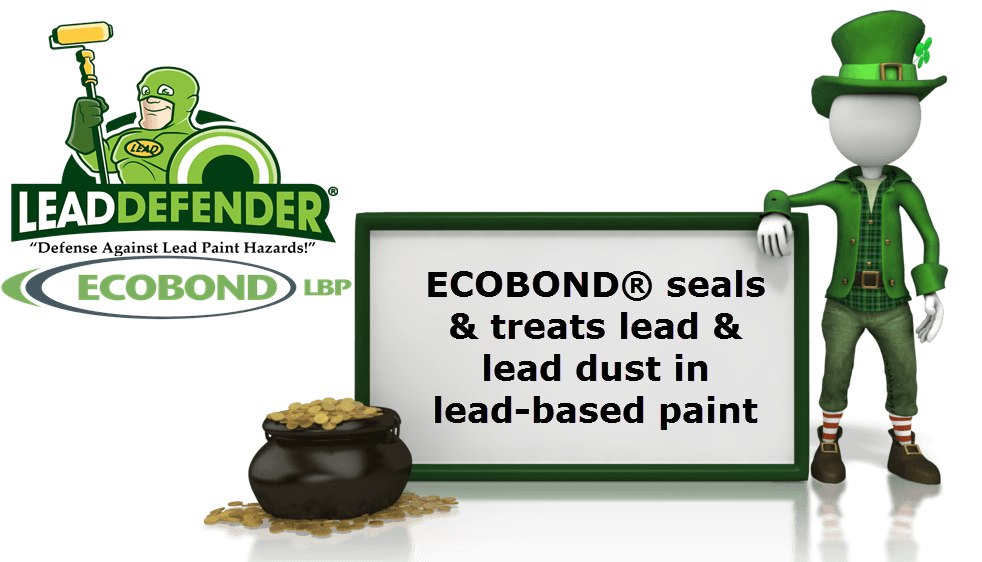 This March 17 you better be wearing green if you don't want to be pinched by a child. If your job keeps you clear of children and children in adult bodies on St. Patrick's Day, consider wearing green anyway in support of the Green Building movement. One way to achieve this is to make sure you do not have any lead based paint in your home. Once you have tested your home with an in-home lead paint testing kit that you can pick up at any Home Depot, if there is any lead paint, you need a Lead-Based Paint Treatment
This March 17 you better be wearing green if you don't want to be pinched by a child. If your job keeps you clear of children and children in adult bodies on St. Patrick's Day, consider wearing green anyway in support of the Green Building movement. One way to achieve this is to make sure you do not have any lead based paint in your home. Once you have tested your home with an in-home lead paint testing kit that you can pick up at any Home Depot, if there is any lead paint, you need a Lead-Based Paint Treatment
What, you may say; I am not much of an environmentalist. That is a common misunderstanding of building green. The green building movement is taking into account not only the environment, but also the economy, and society when designing, engineering, and constructing buildings or remodeling old ones. Building green is a balance between the big three for the most reasoned approach. Its principles should be considered in your company's customer services department, finance and accounting, human resources, you name it.
And building green is not just a part of the construction aspect. Sustainable building practices are part of the project's siting to design, design to construction, construction to operation, maintenance, renovation and eventually even its demolition. It is so much more than sealing up drafty air spaces in the walls. At ECOBOND®, we are especially proud of our part in the green building cycle of safely and economically assisting commercial retrofitters with the evaluation and treatment of possibly lead-paint-laden project sites.
So this St. Patty's Day, wear green, and tell your colleagues you are not afraid of a little pinch, you are just showing your support of the green building movement. Then, contact us to put your support of the color green to work in your next construction or retro-fitting project.
New Study Touts the Benefits of Green Building
Dodge Data & Analytics recently completed a study of global green building trends, with the help of Saint-Gobain, the U.S. Green Building Council and the Regenerative Network. While the study examined green building trends in a number of countries, the section on the United States is cause for much encouragement, but with one or two areas for improvement.
An increasing percentage of respondents reported that at least 60 percent of their new building projects will be green, from 24 percent in 2015 to 39 percent by 2018. Respondents who reported that less than 15 percent of their new projects will be green plunged from 47 percent in 2015 to 27 percent by 2018. While impressive, the numbers are less than those from some other countries such as Brazil, China, and Saudi Arabia.
American firms are increasingly using green building practices in not only new construction of commercial and institutional building (46 percent of American respondents as opposed to 38 percent globally) but on retrofitting older buildings to make them more “green” (43 percent of American respondents as opposed to 37 percent globally.)
76 percent of American respondents note that reducing energy consumption is the greatest reason for engaging in green building practices, double the number of responses that gave reducing water consumption as a reason. Green building practices are paying off, with a nine percent reduction in median operating costs in the first year alone. Green buildings have risen seven percent in value compared to more traditional buildings.
However, only 57 percent of American respondents report using metrics to measure green building performance, as opposed to 75 percent globally, possibly because American builders are the most concerned about the high, upfront costs of green building.
ECOBOND® LBP, LLC is the nation’s leader in developing and distributing products that improve the protection of human health and safety from the hazards of lead in the home, workplace, and the environment. With over 15 years in patented and proven success, the ECOBOND® family of products have been extensively used in successfully treating lead hazards in over 11,000,000 tons of material while serving over 100,000 customers in the United States and Internationally.
To learn more view our lead paint treatment video below
